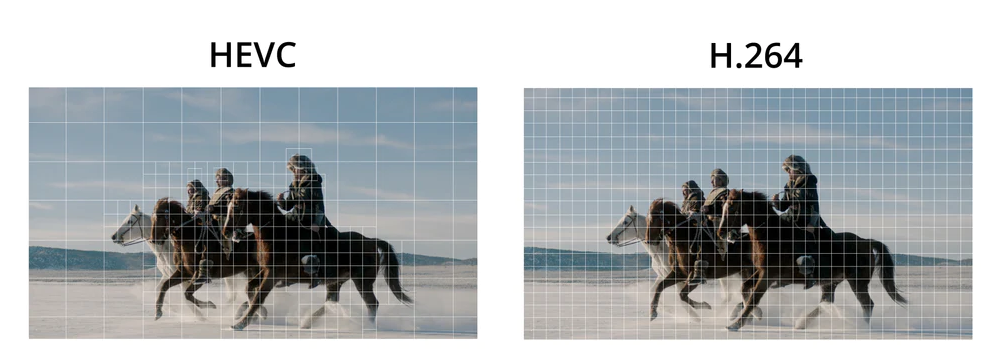EVC stands for High Efficiency Video Coding, which is a video compression standard designed to improve upon the compression efficiency of its predecessor, H.264 (also known as AVC – Advanced Video Coding). HEVC was developed to enable higher quality video streaming and storage while using less bandwidth and storage space compared to older video codecs.
HEVC achieves higher compression efficiency by using advanced techniques such as larger block sizes, improved motion compensation, and more sophisticated entropy coding. These techniques allow for better representation of video content with fewer bits, resulting in higher quality video at lower bitrates. This is especially important for high-resolution content, such as 4K and 8K videos, where the data requirements can be substantial.
Due to its improved compression capabilities, HEVC is commonly used in various applications, including video streaming services, broadcasting, video conferencing, surveillance systems, and more. However, it’s worth noting that the adoption of HEVC has also come with certain licensing complexities, as it is subject to patent licensing fees, which has led to the development of alternative codecs like AV1 that aim to provide similar compression efficiency without the same licensing constraints.
Support
HEVC (High Efficiency Video Coding) is a widely adopted video compression standard, and many devices support it to provide efficient video playback and streaming. Here are some types of devices that often support HEVC:
- Smartphones and Tablets: Many modern smartphones and tablets are equipped with hardware decoding capabilities for HEVC. This allows users to watch high-quality videos without consuming excessive battery or data.
- Smart TVs: Most contemporary smart TVs come with HEVC support. This is particularly important for displaying high-resolution content, such as 4K and HDR videos, while conserving network bandwidth or storage space.
- Streaming Devices: Popular streaming devices like Roku, Amazon Fire TV, Apple TV, and Google Chromecast often include HEVC support to enable smooth streaming of high-quality videos from various online platforms.
- Gaming Consoles: Modern gaming consoles like PlayStation and Xbox generally include HEVC decoding capabilities. This is helpful for watching videos or streaming content through these devices.
- Laptops and Computers: Many newer laptops and desktop computers have hardware acceleration for HEVC decoding. This enables smoother video playback while minimizing the strain on the CPU.
- Digital Cameras and Camcorders: Some digital cameras and camcorders that record in high-resolution formats use HEVC for efficient storage of video files without compromising quality.
- Media Players: Dedicated media players, both standalone and software-based, often support HEVC playback. These players are commonly used to play videos from local storage devices.
- Set-Top Boxes: Cable or satellite set-top boxes that deliver high-definition or ultra-high-definition content may utilize HEVC to deliver better video quality over limited bandwidth.
- Video Editing Software: Video editing software applications may support importing, editing, and exporting videos encoded in HEVC format.
- Online Video Platforms: Streaming services like Netflix, YouTube, and Amazon Prime Video often use HEVC to deliver high-quality content to viewers while minimizing bandwidth usage.
It’s important to note that while many devices support HEVC, compatibility can vary based on the specific model and manufacturer. Additionally, the availability of hardware decoding for HEVC can greatly affect the performance and energy efficiency of the device.
MIRROR HERE♥
Pros and Cons HEVC
Pros:
- Higher Compression Efficiency: HEVC offers significantly better compression efficiency compared to its predecessors, allowing high-quality videos to be streamed or stored using less bandwidth and storage space.
- Support for High Resolutions: HEVC is particularly effective for high-resolution content like 4K and 8K videos, where the benefits of efficient compression are more pronounced.
- Improved Video Quality: HEVC’s advanced compression techniques lead to better representation of video content, resulting in improved video quality even at lower bitrates.
- Enhanced Streaming Experience: With HEVC, users can enjoy smoother streaming experiences as it requires less bandwidth, reducing buffering and providing higher quality playback.
- Versatility: HEVC can be used in a wide range of applications, from streaming services and broadcasting to video conferencing and surveillance systems.
- Future-Proofing: Given its advanced compression techniques, HEVC is likely to remain relevant for a long time, even as technology advances.
Cons:
- Licensing Costs: HEVC is subject to patent licensing fees, which can complicate its adoption and increase costs for companies using the technology.
- Processing Demands: Decoding HEVC-encoded videos requires more processing power compared to older codecs, which can affect battery life on mobile devices and strain less powerful hardware.
- Complexity: The advanced compression techniques in HEVC make it more complex to encode and decode, potentially requiring more sophisticated hardware and software.
- Compatibility: While support for HEVC has grown, not all devices and software applications may fully support it, leading to compatibility issues for some users.
- Competition from Royalty-Free Codecs: The licensing concerns around HEVC have spurred the development of royalty-free codecs like AV1, which aim to provide similar compression efficiency without the associated licensing costs.
- Transition Period: The transition from older codecs to HEVC can take time, as older devices and software may need updates to support the new standard fully.
It’s important to consider these pros and cons when deciding whether to use HEVC for your specific video streaming, storage, or communication needs.
